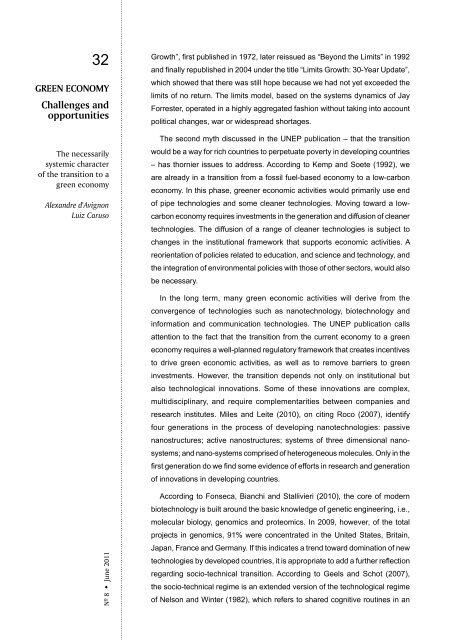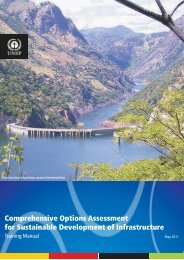Download Publication - Rio+20
Download Publication - Rio+20
Download Publication - Rio+20
Create successful ePaper yourself
Turn your PDF publications into a flip-book with our unique Google optimized e-Paper software.
32<br />
GREEN ECONOMY<br />
Challenges and<br />
opportunities<br />
The necessarily<br />
systemic character<br />
of the transition to a<br />
green economy<br />
Alexandre d'Avignon<br />
Luiz Caruso<br />
Growth”, first published in 1972, later reissued as “Beyond the Limits” in 1992<br />
and finally republished in 2004 under the title “Limits Growth: 30-Year Update”,<br />
which showed that there was still hope because we had not yet exceeded the<br />
limits of no return. The limits model, based on the systems dynamics of Jay<br />
Forrester, operated in a highly aggregated fashion without taking into account<br />
political changes, war or widespread shortages.<br />
The second myth discussed in the UNEP publication – that the transition<br />
would be a way for rich countries to perpetuate poverty in developing countries<br />
– has thornier issues to address. According to Kemp and Soete (1992), we<br />
are already in a transition from a fossil fuel-based economy to a low-carbon<br />
economy. In this phase, greener economic activities would primarily use end<br />
of pipe technologies and some cleaner technologies. Moving toward a lowcarbon<br />
economy requires investments in the generation and diffusion of cleaner<br />
technologies. The diffusion of a range of cleaner technologies is subject to<br />
changes in the institutional framework that supports economic activities. A<br />
reorientation of policies related to education, and science and technology, and<br />
the integration of environmental policies with those of other sectors, would also<br />
be necessary.<br />
In the long term, many green economic activities will derive from the<br />
convergence of technologies such as nanotechnology, biotechnology and<br />
information and communication technologies. The UNEP publication calls<br />
attention to the fact that the transition from the current economy to a green<br />
economy requires a well-planned regulatory framework that creates incentives<br />
to drive green economic activities, as well as to remove barriers to green<br />
investments. However, the transition depends not only on institutional but<br />
also technological innovations. Some of these innovations are complex,<br />
multidisciplinary, and require complementarities between companies and<br />
research institutes. Miles and Leite (2010), on citing Roco (2007), identify<br />
four generations in the process of developing nanotechnologies: passive<br />
nanostructures; active nanostructures; systems of three dimensional nanosystems;<br />
and nano-systems comprised of heterogeneous molecules. Only in the<br />
first generation do we find some evidence of efforts in research and generation<br />
of innovations in developing countries.<br />
Nº 8 • June 2011<br />
According to Fonseca, Bianchi and Stallivieri (2010), the core of modern<br />
biotechnology is built around the basic knowledge of genetic engineering, i.e.,<br />
molecular biology, genomics and proteomics. In 2009, however, of the total<br />
projects in genomics, 91% were concentrated in the United States, Britain,<br />
Japan, France and Germany. If this indicates a trend toward domination of new<br />
technologies by developed countries, it is appropriate to add a further reflection<br />
regarding socio-technical transition. According to Geels and Schot (2007),<br />
the socio-technical regime is an extended version of the technological regime<br />
of Nelson and Winter (1982), which refers to shared cognitive routines in an

















